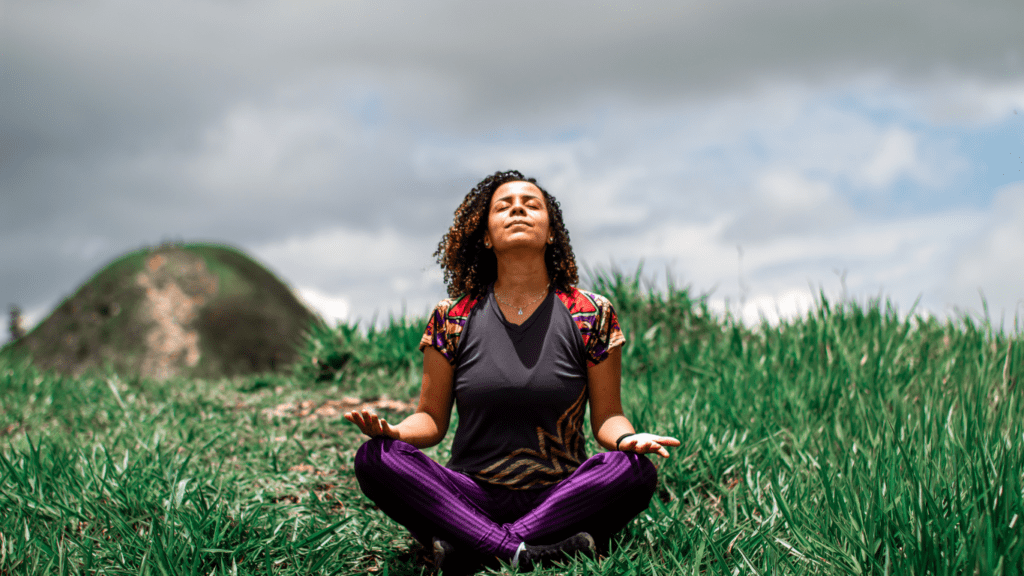The Importance of Guided Meditations
Guided meditations play a crucial role in helping beginners start their meditation journey. These meditations provide clear instructions, ensuring that even those new to the practice can follow along without feeling overwhelmed. By listening to a guide, individuals can focus more on the experience rather than worrying about what to do next.
Research shows that guided meditations offer several benefits, including stress reduction, improved focus, and emotional well-being. Studies by the American Psychological Association have found that regular meditation can decrease cortisol levels, a primary stress hormone, improving overall mental health. For beginners, having a structured meditation session increases adherence, enhancing these benefits over time.
Additionally, guided meditations introduce a variety of techniques, such as:
- mindfulness
- visualization
- body scanning
This diverse approach keeps the practice engaging, encouraging consistency. For instance, mindfulness meditation helps individuals stay present, while visualization aids in achieving specific goals or states of mind.
Guided meditations also support the development of a regular practice. Consistency is key to reaping the full benefits of meditation. By scheduling sessions with a guide, beginners can establish a routine that integrates seamlessly into their daily life. This practice fosters discipline, ensuring long-term commitment.
Guided meditations ease the initial learning curve, offering structured support, various techniques, and fostering a consistent practice. These elements are essential for beginners seeking the transformative effects of meditation.
Choosing the Right Meditation Guide
Several options exist for guided meditations, making the right choice crucial. Not every guide resonates with every individual, so it’s vital to explore different formats and sources.
Audio Versus Video Guides
Audio guides provide flexibility. They allow for meditation anywhere and anytime without needing a screen. Popular platforms like Calm and Insight Timer offer numerous audio sessions. Beginners often find audio guides less distracting since there’s no visual component, enabling deeper focus and immersion. However, if visual cues aid in relaxation and focus, video guides might be preferable.
Video guides offer visual engagement. They often include soothing imagery and demonstrations of proper posture and technique. Platforms like YouTube and Headspace provide a wide selection of video guides.
Some people find visual guidance reduces uncertainty about physical alignment, enhancing their practice. Yet, video guides require a screen, which may limit mobility and requires a quiet space with a stable internet connection.
Popular Meditation Apps
Several apps stand out in the realm of guided meditations. They offer structured programs tailored to beginners.
- Calm: Known for its extensive library of calming audio meditations, Calm includes programs for stress management, sleep improvement, and focus enhancement. It features well-known narrators and customizable sessions, making it highly adaptable.
- Headspace: Headspace offers beginner-friendly courses with a focus on mindfulness and foundational practices. It provides both audio and video content, ensuring a comprehensive approach. Headspace also introduces various techniques, allowing beginners to explore different methods.
- Insight Timer: Insight Timer stands out with its vast user-generated content. It provides thousands of free meditations, covering various styles and lengths. The app’s community feature encourages sharing experiences and discoveries.
Choosing the right guide means understanding what format and platform best support your meditation goals and preferences. Explore different guides to find the one that resonates with you most profoundly.
Preparing for Your First Guided Meditation
Begin your meditation journey by carefully preparing your environment. This helps create a comfortable and distraction-free experience.
Setting Up Your Space
Choose a quiet, clean area to meditate. Remove any clutter to help focus. Include a comfortable chair or cushion for seated meditations. Use dim lighting or candles to create a calming atmosphere. Consider adding elements like incense or essential oils to enhance relaxation.
What to Wear
Opt for loose, comfortable clothing for meditation. Avoid tight or restrictive attire that might cause discomfort or distraction. Natural fabrics, such as cotton, are preferable for their breathability. If meditating in cooler environments, have a light blanket nearby.
Timing and Duration
Decide on a specific time of day for your meditation to create consistency. Morning sessions can set a positive tone for the day, while evening sessions help unwind. Start with short durations, like 5-10 minutes, gradually increasing as you become more comfortable. Use a timer or meditation app to manage your session length.
Step-by-Step Guide to Guided Meditations
Embarking on guided meditations requires simple steps tailored to enhance your experience. Here’s a structured guide to walk you through the process.
Finding a Comfortable Position

Start by selecting a position that promotes relaxation yet keeps you alert. Common choices include sitting on a cushion or chair with your spine straight. Ensure your hands rest comfortably on your lap or knees. If sitting isn’t possible, lying down works too, though it may increase the possibility of falling asleep. Choose a position that supports focus and ease.
Focusing on Your Breath
Shift your attention to your breathing. Notice the rhythm and depth without altering it. Focus on each inhale and exhale, feeling the air entering and leaving your body. If thoughts arise, observe them without attachment, gently redirecting your focus to your breath. This practice helps anchor your mind and fosters a deeper meditative state.
Following the Guide’s Instructions
Listen attentively to the instructions provided by your chosen meditation guide. Follow their cues for visualization, relaxation, or specific meditation techniques.
Trust the process and allow their voice to lead you through each step, enhancing your mindfulness practice. Let the guide’s prompts assist in navigating through your inner landscape, ensuring a structured and immersive meditation session.
Benefits of Guided Meditations
Guided meditations offer numerous advantages for both physical and mental well-being. Understanding these benefits can help you appreciate the full value of incorporating guided sessions into your daily routine.
Physical Health Benefits
Guided meditations contribute to several physical health improvements. By reducing stress levels, they can lower blood pressure, improving cardiovascular health.
According to a study published in the Journal of Alternative and Complementary Medicine, regular meditation practice can decrease hypertension. Additionally, consistent meditation sessions enhance sleep quality by calming the mind, leading to better overall health.
Engaging in guided meditations also helps alleviate pain. For instance, individuals suffering from chronic pain conditions report reduced pain perception when incorporating meditation into their treatment plans. Meditation can help reduce inflammation, attributed to lower stress hormones like cortisol.
Mental and Emotional Health Benefits
Guided meditations significantly boost mental and emotional health. They help reduce symptoms of anxiety and depression by promoting a sense of calm and relaxation. According to a meta-analysis in the journal JAMA Internal Medicine, meditation can effectively mitigate stress and anxiety.
These meditative practices also improve focus and concentration. By training the mind to remain present, they enhance cognitive functions and productivity. Moreover, guided meditations support emotional well-being by fostering self-awareness and emotional regulation. Practitioners often report feeling more balanced and emotionally resilient, enabling them to manage life’s challenges more effectively.
By understanding the broad spectrum of benefits, you can fully embrace the practice of guided meditations and integrate it into your lifestyle.
Common Challenges and How to Overcome Them
Guided meditations can be incredibly rewarding, but beginners often face common challenges. Identifying and addressing these issues can help maintain consistency and enhance the benefits of meditation.
Difficulty in Concentration
Maintaining focus during meditation can seem daunting for beginners. Mind-wandering is a common issue. To counteract this, I suggest focusing on your breath. Pay attention to each inhale and exhale. If thoughts arise, acknowledge them without judgment, then gently return your focus to your breath. Using guided meditations that include breathing exercises, such as those available on apps like Headspace or Calm, can be beneficial.
Dealing with Discomfort
Physical discomfort, such as back pain or tightness, can disrupt meditation sessions. To mitigate this, adopt a comfortable position. Sitting on a cushion or chair, ensuring your back is straight yet relaxed, can help. Incorporating brief stretching exercises before meditation can also alleviate stiffness. If discomfort persists, consider short meditation sessions and gradually increase the duration as your body adapts.
Managing Expectations
Unrealistic expectations can lead to frustration and loss of motivation. It’s crucial to understand that meditation is a skill that develops over time. I recommend setting realistic goals.
Instead of aiming for long, uninterrupted sessions, start with just five minutes daily and gradually extend the timeframe. Remember, progress can be incremental. Leveraging tools like meditation journals to track your journey can provide insights and maintain motivation.
By addressing these common challenges proactively, beginners can optimize their guided meditation practice and fully experience its benefits.
 Albert Newman has been a dedicated contributor to Top Wellness Activity Hub, leveraging his extensive background in digital content creation to enrich the platform with engaging and valuable information. Known for his meticulous research and a knack for simplifying complex wellness topics, Albert focuses on producing content that is both informative and approachable. His articles cover a broad spectrum of wellness subjects, from healthy eating habits to the latest trends in yoga and fitness. Albert's ability to break down intricate health concepts into easily digestible insights has made the platform a trusted source for wellness advice.
Beyond his writing, Albert is also deeply involved in the content strategy and editorial planning of the platform. His collaborative approach ensures that each piece of content aligns with the platform’s mission to empower users on their wellness journey. Albert is always exploring innovative ways to engage readers, whether through interactive guides or personalized wellness tips. His commitment to creating high-quality, reader-centric content plays a significant role in the platform’s ongoing success.
Albert Newman has been a dedicated contributor to Top Wellness Activity Hub, leveraging his extensive background in digital content creation to enrich the platform with engaging and valuable information. Known for his meticulous research and a knack for simplifying complex wellness topics, Albert focuses on producing content that is both informative and approachable. His articles cover a broad spectrum of wellness subjects, from healthy eating habits to the latest trends in yoga and fitness. Albert's ability to break down intricate health concepts into easily digestible insights has made the platform a trusted source for wellness advice.
Beyond his writing, Albert is also deeply involved in the content strategy and editorial planning of the platform. His collaborative approach ensures that each piece of content aligns with the platform’s mission to empower users on their wellness journey. Albert is always exploring innovative ways to engage readers, whether through interactive guides or personalized wellness tips. His commitment to creating high-quality, reader-centric content plays a significant role in the platform’s ongoing success.